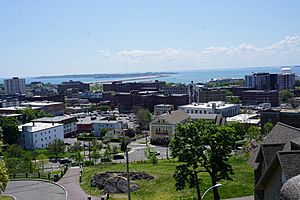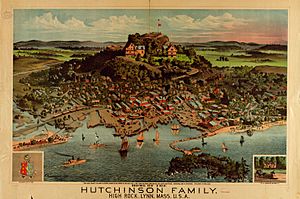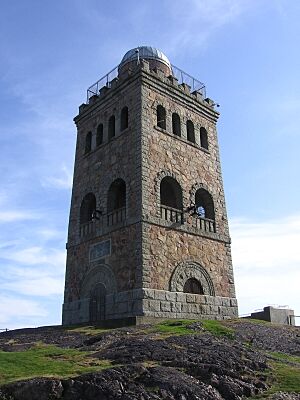Lynn, Massachusetts facts for kids
Quick facts for kids
Lynn
|
|||
|---|---|---|---|
|
City
|
|||

Downtown Lynn
|
|||
|
|||
| Nicknames:
"City of Sin" and "City of Firsts"
|
|||

Location in Essex County and Massachusetts.
|
|||
| Country | United States | ||
| State | Massachusetts | ||
| County | Essex | ||
| Settled | 1629 | ||
| Incorporated (Town) | 1629 | ||
| Named | 1637 | ||
| Incorporated (City) | May 14, 1850 | ||
| Named for | King's Lynn, Norfolk, England | ||
| Government | |||
| • Type | Mayor-council city | ||
| • Body | Executive Branch (Mayor) and Legislative Branch (City Council) | ||
| Area | |||
| • Total | 13.52 sq mi (35.02 km2) | ||
| • Land | 10.74 sq mi (27.81 km2) | ||
| • Water | 2.78 sq mi (7.20 km2) | ||
| Elevation | 30 ft (9 m) | ||
| Population
(2020)
|
|||
| • Total | 101,253 | ||
| • Density | 9,428.53/sq mi (3,640.41/km2) | ||
| Demonym(s) | Lynner | ||
| Time zone | UTC−5 (Eastern) | ||
| • Summer (DST) | UTC−4 (Eastern) | ||
| ZIP Codes |
01901–01905
|
||
| Area codes | 339/781 | ||
| FIPS code | 25-37490 | ||
| GNIS feature ID | 0613376 | ||
Lynn is a vibrant city in Massachusetts, United States. It's the eighth-largest city in the state and the biggest in Essex County. Lynn is located right on the Atlantic Ocean, just a short distance north of Boston.
This historic city was settled by Europeans in 1629, making it one of the oldest colonial settlements in Massachusetts. Lynn was once known as the "City of Sin" due to its past. Today, it's famous for its cool public art, diverse population, beautiful old buildings, and many parks. These include the oceanfront Lynn Shore Reservation and the huge Lynn Woods Reservation. Lynn is also home to Lynn Heritage State Park and the seaside Diamond Historic District. In 2020, about 101,253 people called Lynn home.
Contents
Lynn's Rich History
Early Days and Native Americans
Before Europeans arrived, the area of Lynn was home to Native Americans for thousands of years. The Naumkeag people, led by their powerful chief Nanepashemet, lived here. English colonists settled Lynn in 1629, calling it Saugus at first. They later made agreements with the Naumkeag people about the land.
How Lynn Got Its Name
Lynn got its name from King's Lynn, a town in Norfolk, England. This was done in 1637 to honor Reverend Samuel Whiting (Senior), who was Lynn's first official minister and came from King's Lynn.
Growth and New Towns
As more English settlers came, new towns were formed from parts of Lynn. These included Reading (1644), Lynnfield (1782), Saugus (1815), Swampscott (1852), and Nahant (1853). Lynn officially became a city on May 14, 1850.
Lynn's Shoe-Making Legacy
Early Lynn was a major center for making shoes. This industry started in 1635. Even the boots worn by soldiers during the Revolutionary War were made in Lynn! This history is shown on the city's seal, which has a colonial boot on it.
Transportation and Industry in the 1800s
In the 1800s, transportation improved with mail coaches and then the Eastern Railroad in 1838. Lynn's industry grew too. Shoe manufacturers invested in the new electric industry. In 1892, the Thomson-Houston Electric Company in Lynn merged with Edison Electric Company to form General Electric. Lynn became one of the first two GE plants.
The General Electric plant in Lynn first made electric motors and meters. Later, it became important for making aircraft electrical systems and jet engines, especially during World War II. This work continues today, thanks to research and improvements in jet engine technology.
Important Moments for Workers and Rights
One of the biggest worker strikes in early American history happened in Lynn's shoe factories on February 22, 1860. Shoemakers protested against lower wages.
Frederick Douglass, a famous abolitionist who fought against slavery, lived in Lynn as a free man starting in 1841. He wrote his first autobiography, Narrative of the Life of Frederick Douglass, an American Slave, while living here.
Fires and Rebuilding
Lynn faced some big fires in its history. In 1889, a massive fire destroyed many buildings downtown, including homes and businesses. It was one of the largest fires in New England at the time. Another huge fire in 1981 destroyed old shoe factories, causing a lot of damage and job losses. The North Shore Community College campus now stands in much of that burned area.
Lynn: The City of Firsts
To improve its image, Lynn launched a "City Of Firsts" campaign in the 1990s. It highlighted many cool things that happened first in Lynn, such as:
- The first iron works (1643)
- The first fire engine (1654)
- The first electric streetcar in Massachusetts (1888)
- The first American jet engine
- The first woman in advertising and mass-marketing – Lydia Pinkham
- The first baseball game played under artificial light
- The first dance academy in the U.S.
- The first tannery (leather factory) in the U.S.
- The first air mail transport in New England
- The first roast beef sandwich
- The first tulip in the United States
Lynn Today: A Revitalized City
In the early 2000s, Lynn began a big revitalization project. Old buildings were fixed up, and new ones were built. Arts, culture, and entertainment became a big focus, with new art groups, venues, and restaurants. In 2012, downtown Lynn was recognized as one of Massachusetts' first official arts and culture districts.
Many old industrial buildings are now being turned into cool loft apartments. New buildings are also going up, especially near Lynn station, which offers quick train service to Boston. In 2017, the city started the "Beyond Walls" festival, where artists painted large murals on buildings downtown, making the city even more colorful and exciting.
Lynn has also become a welcoming place for the LGBT community. In 2018, The Boston Globe newspaper even named Lynn one of the "Top spots to live in Greater Boston in 2018."
In 2021, the new Frederick Douglass Park was opened on Exchange Street, featuring a sculpture of Douglass. The city is also working on "Vision Lynn," a 20-year plan to improve its diversity and infrastructure.
Where is Lynn Located?
Lynn is on Massachusetts Bay and the Atlantic Ocean. The town of Nahant divides Lynn's shoreline into Lynn Harbor to the south and Nahant Bay to the north. The city has several ponds, like Breed's Pond and Walden Pond.
Over a quarter of Lynn's land is covered by the Lynn Woods Reservation. This huge park is in the northwestern part of the city. Lynn also has two beaches, Lynn Beach and King's Beach, both on Nahant Bay.
Lynn is about 10 miles (16 km) northeast of Boston. It shares borders with Nahant, Swampscott, Salem, Peabody, Lynnfield, Saugus, and Revere.
Lynn's Neighborhoods
Lynn is divided into different areas, each with its own feel:
- Central: Downtown / Business District, Central Square
- West Lynn: Pine Hill, McDonough Sq./ Barry Park, Tower Hill / Austin Sq., The Commons, The Brickyard, Walnut St./Lynnhurst, Veteran's Village
- East Lynn: Diamond District / Lynn Shore, Wyoma Sq., The Highlands, The Fay Estates, Ward 1 / Lynnfield St., Goldfish Pond, The Meadow / Keaney Park
Lynn's Population and Diversity
| Historical population | ||
|---|---|---|
| Year | Pop. | ±% |
| 1790 | 2,291 | — |
| 1800 | 2,837 | +23.8% |
| 1810 | 4,087 | +44.1% |
| 1820 | 4,515 | +10.5% |
| 1830 | 6,138 | +35.9% |
| 1840 | 9,367 | +52.6% |
| 1850 | 14,257 | +52.2% |
| 1860 | 19,083 | +33.9% |
| 1870 | 28,233 | +47.9% |
| 1880 | 38,274 | +35.6% |
| 1890 | 55,727 | +45.6% |
| 1900 | 68,513 | +22.9% |
| 1910 | 89,336 | +30.4% |
| 1920 | 99,148 | +11.0% |
| 1930 | 102,320 | +3.2% |
| 1940 | 98,123 | −4.1% |
| 1950 | 99,738 | +1.6% |
| 1960 | 94,478 | −5.3% |
| 1970 | 90,294 | −4.4% |
| 1980 | 78,471 | −13.1% |
| 1990 | 81,245 | +3.5% |
| 2000 | 89,050 | +9.6% |
| 2010 | 90,329 | +1.4% |
| 2020 | 101,253 | +12.1% |
| 2023* | 101,241 | −0.0% |
| * = population estimate. Source: United States Census records and Population Estimates Program data. Source: |
||
Lynn is a very diverse city. In 2020, its population was 101,253. Many different ethnic groups call Lynn home. For example, a large part of the population is Hispanic or Latino, including people from the Dominican Republic, Guatemala, and Puerto Rico. There's also a significant Asian population, with many people of Cambodian and Vietnamese heritage.
Fun Places and Activities in Lynn
Notable Locations to Visit
Lynn has many interesting places:
- Fraser Field: A municipal baseball stadium built in the 1940s. It hosts the North Shore Navigators baseball team.
- Manning Field: The city's football stadium.
- Lynn Memorial Auditorium: A place for shows and events.
- Mary Baker Eddy House: A historic home.
- Capitol Diner: A classic diner.
- Lynn Museum & Historical Society: Learn about Lynn's past.
Parks and Green Spaces
Lynn is proud of its many parks and open spaces. In fact, about 22% of the city's land is dedicated to parks! This means almost everyone in Lynn lives within a 10-minute walk of a park.
- Lynn Shore Reservation: A beautiful park along the ocean.
- Lynn Woods Reservation: The largest municipal park in New England, covering 2,200 acres (8.9 km²). It has historical sites like Stone Tower, Steel Tower, the Wolf Pits, and Dungeon Rock, which is believed to hide pirate treasure. Many schools use Lynn Woods for cross-country track meets.
- Lynn Commons: A green area in the city center.
- Lynn Heritage State Park: Another great park for history and nature.
- High Rock Tower: A stone tower with amazing views of Nahant, Boston, and the ocean. You can even use a telescope at the top!
- Pine Grove Cemetery: One of the largest cemeteries in the country, known for its long stone wall.
- Northern Strand Community Trail: A trail that connects Lynn to other nearby towns like Revere and Saugus.
Learning and Education in Lynn
Lynn has a strong public school system. It includes three public high schools: Lynn English, Lynn Classical, and Lynn Vocational Technical High School. There are also middle schools and many elementary schools.
For those interested in other options, Lynn has KIPP Academy Lynn, a charter school, and St. Mary's High School, an independent Catholic high school.
If you're thinking about college, North Shore Community College has a campus right in downtown Lynn.
Getting Around Lynn
Lynn doesn't have any major highways directly passing through it, but several state routes help people get around. Route 1A, Route 107, and Route 129 all go through the city. The Lynnway is a divided highway that runs along the coast.
For public transportation, Lynn is served by Lynn station on the MBTA Commuter Rail system, which connects to Boston. There are also many MBTA bus routes. A ferry service to downtown Boston has also operated in recent years. The closest airport is Logan International Airport in Boston, which is about 5 miles (8 km) away.
Famous People from Lynn
Many interesting people have connections to Lynn, including:
- Harry Agganis: A talented football and baseball player.
- Verna Bloom: An American actress.
- Walter Brennan: An actor who won three Academy Awards.
- Frederick Douglass: The famous abolitionist.
- Mary Baker Eddy: The founder of Christian Science.
- Neil Hamilton: The actor who played Commissioner Gordon on the Batman TV show.
- Jan Ernst Matzeliger: An inventor who greatly improved shoe-making equipment.
- Alex Newell: An actor and singer from the TV show Glee.
- Ruth Roman: An actress known for Strangers on a Train.
- Lesley Stahl: A well-known television journalist from 60 Minutes.
Images for kids
See also
 In Spanish: Lynn (Massachusetts) para niños
In Spanish: Lynn (Massachusetts) para niños














